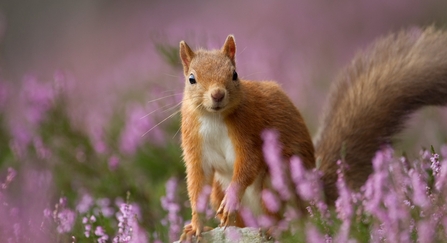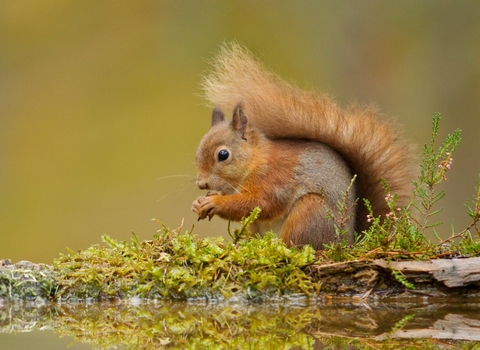
Northumberland Wildlife Trust and partners can proudly announce that we have been awarded a fantastic 4.86 million by The National Lottery Heritage Fund for our Red Squirrel Recovery Network (RSRN) project! Thanks to National Lottery players, this 5-year initiative will help protect and conserve our beloved red squirrels across Northern England and Southern Scotland.
RSRN is an ambitious project which will work at a super-landscape scale to bring about lasting change for red squirrels, who would be lost in 10 years without continuous and extensive conservation effort.
We are at a critical point for the recovery of red squirrels across the UK. For the first time, RSRN will bring together conservation partners and 50+ volunteer groups to work across the Southern Scotland/ Northern England red squirrel range. Due to grey squirrel only areas now firmly established to the north and south of this area, and grey squirrel incursion occurring regularly, red squirrels in this region are extremely vulnerable to extinction.

Red squirrel. Image by: Peter Cairns/2020VISION.
What will be delivered?
In the initial development stage (first year) of the project, partners worked together to collect baseline data across the project areas on squirrel distribution, grey squirrel management activity and volunteer demographics to establish the current range of volunteers as well as identify opportunities to encourage new volunteers. Conservation and communication plans were developed and emerging science built on to support the delivery of grey squirrel fertility control and the annual squirrel Spring Monitoring Programme (Spring Monitoring Programme). Following the development phase, and upon being awarded the grant from the National Heritage Fund in 2025, the five-year delivery phase has now begun. Some of the deliverables throughout the project will include:
- Building on emerging science to carry out field trials relating to fertility control for grey squirrels and establish new methodologies which are potentially transformative for the future of red squirrels
- For the first time, employing a dedicated Communications Officer to audiences within and beyond the project area including responding to volunteer requests to increase profile/raise awareness, using new opportunities to build a more resilient supporter base for the red squirrel conservation movement . The project will also be working to spread the word about the challenges red squirrels face, through the new Don’t be Shy campaign
- Engaging new audiences within the red squirrel range – involving more volunteers to support existing local groups and building a wider network of engaged and aware people in local communities and the general public
- Utilising the endearing red squirrel as an opportunity to connect new audiences most in need to explore woodlands, notice nature, develop skills, feel less isolated, connect with their community and, potentially, see one of our most iconic species in its natural habitat. In particular, providing new targeted activities which will benefit communities in South and East Ayrshire, West Cumbria Coast, South East Northumberland and Knowsley
- Working with volunteers and communities in rural areas to understand and monitor the potential impact of pine martens
- Improving data sharing across the area to build a more coherent picture of current status and likely impact of new game-changing interventions
- Sustaining current conservation efforts, ensuring that decades of investment are not lost just at the time when more sustainable approaches are on the horizon
- Providing training, equipment and other support to local groups and volunteers at local and regional/national levels
- Providing small grants for local projects which support local volunteer action (delivered by squirrel groups or other community groups)
- Working with current and new partners to secure a future for reds and resilient woodlands/forests across the north of England and Southern Scotland – this will include working with partners and landowners to establish new income streams for red squirrel conservation
Using the information gathered over the development phase, the partnership team will now work with volunteers and landowners to help safeguard and grow the remaining red squirrel population. In addition they will be looking to provide grants to local community groups to enable them to undertake their own red squirrel conservation projects such as engagement activities and squirrel themed events in their project areas.
The project also plans to engage new audiences with the importance of red squirrel conservation and raise awareness of their plight. The project also aims to engage more people with the species to build an even bigger volunteer community and connect people to nature.
A big thank you to The National Lottery Heritage Fund and the players for making this possible!
How can you help?
You can also help by enjoying a pint of Allendale Brewery’s new Red Squirrel Pale Ale! The brewery is launching the ale to coincide with Red Squirrel Awareness Week. A proportion of the profits from every pint sold will be donated, helping to protect and restore red squirrel populations across the UK. Red Squirrel Ale is available in cask, cans, bottles and eventually pubs across the north of England to both on and off trade customers — offering an opportunity to enjoy a locally brewed beer while directly contributing to the survival of our reds. Buy yours now from Allendale Brewery.
There are several other ways you can effectively support the work of RSRN, including
- Report your sightings of red and grey squirrels Every sighting we receive helps feed into a larger database, which is crucial for us to monitor whether what we are doing is paying off and where we might need to focus more effort
- Become a friend of the red squirrel For as little as £2 a month, you’ll be supporting essential conservation work — and helping to secure a future for these charismatic animals. All funds go directly towards saving our reds, and you'll receive a lovely welcome pack in addition to annual newsletters.
- Join your local Red Squirrel Group - meet like-minded advocates of red squirrels
- Become a corporate member - become a corporate member and invest in red squirrels through our Friends of the Red Squirrel Red Squirrel Corporate Membership scheme.
More information can be found here. Or please contact: info@rsne.org.uk
Join the team - RSRN careers
Red squirrel FAQ
Understanding threats, conservation, and the future
Why are red squirrel populations struggling in the UK?
Red squirrel numbers have declined sharply over the past century due to several pressures. The introduction of non-native grey squirrels has had the greatest impact, as greys compete for food and habitat and also carry the squirrelpox virus, which is fatal to reds. At the same time, the loss and fragmentation of woodland have reduced suitable areas for them to survive. Once widespread across the UK, red squirrels are now mainly limited to Scotland, northern England, Ireland, and some isolated areas where they are carefully protected. Conservation projects are helping to protect remaining populations, but the species remains at risk in much of its former range.
What impact did introducing grey squirrels have on red squirrels?
Grey squirrels were first introduced to England from North America in 1876 as an ornamental species to populate the grounds of stately homes. Around 30 separate introductions occurred until 1930 when the damage caused by the grey squirrel was recognised and it was made illegal to release a grey squirrel to the wild. Grey squirrels have rapidly spread and colonised much of mainland England with detriment to our native red squirrel. The most significant threat associated with grey squirrels is the spread and transmission of a disease called squirrelpox virus (SQPV). It can take only one grey squirrel to introduce this virus to a local population of red squirrels and then the virus can spread throughout the reds with devastating effect. Where a grey squirrel introduces SQPV, red squirrel population decline has been observed at between 17-25 times quicker than through competition alone. Grey squirrels will also out-compete red squirrels for food, as they are able to eat nuts and seeds before they ripen, whilst reds can’t, leaving them with less available food.
Can red squirrels catch squirrelpox from other red squirrels?
Yes. The squirrelpox virus is most often introduced to red squirrel populations through contact with grey squirrels, who can carry the virus without becoming seriously ill. Transmission can happen directly through close contact or indirectly via contaminated surfaces such as feeders, food sources, or shared nesting areas. Once the virus is present in a group of red squirrels, it does not rely on grey squirrels to spread further. Infected red squirrels can pass it on to others, allowing the disease to circulate within the population. This makes outbreaks particularly serious, as the virus is usually fatal to reds and can cause rapid local declines once established.
Are there any signs that red squirrels are developing resistance to squirrelpox?
At present, there's limited evidence suggesting red squirrels are evolving resistance. Research continues, but immunity within wild red populations remains extremely low, and outbreaks are typically severe.
Is completely removing grey squirrels from the UK possible?
Complete removal of grey squirrels from the UK is unlikely. Since their introduction in the late 19th and early 20th centuries, grey squirrels have spread widely and now occupy most of England, Wales, and parts of Scotland. Their ability to reproduce quickly and adapt to a variety of woodland habitats makes eradication impractical on a national scale. However, local management can make a significant difference. In areas where grey populations are controlled, red squirrels are able to recover and maintain stable numbers. Targeted control, combined with habitat management and community involvement, is therefore a key part of conservation strategies to protect remaining red squirrel populations.
How do pine martens help red squirrel conservation?
Research indicates that pine martens, medium-sized predators native to the UK, may play an important role in supporting red squirrel conservation. Studies show that pine martens seem to prey more frequently on grey squirrels than on reds. Grey squirrels are larger, slower, and spend more time on the ground, making them more vulnerable to predation. Red squirrels, in contrast, are lighter, quicker, and more arboreal, which helps them avoid being targeted as often. Red squirrels also co-evolved alongside the predator resulting in an natural instinct to avoid them. Pine martens are currently being reintroduced across the UK following large-scale persecution of the species.
Are there alternatives to removing grey squirrels?
Yes. While culling has been the most common method of controlling grey squirrel numbers, researchers and conservationists are exploring alternative approaches. One option under investigation is the use of oral contraceptives delivered through bait, aiming to reduce grey squirrel reproduction. It is hoped the contraceptive will be ready for delivery within a decade. Another approach being looked into is the use of genetic technologies such as gene drives to limit population growth over time, though this is not yet close to practical application.
In addition to direct population control, habitat management can also play a role. Woodlands dominated by Scots pine or conifer species tend to favour red squirrels, which are better adapted to these habitats than greys. Creating or maintaining such environments can help give reds a competitive advantage.
Is habitat loss more of a problem than grey squirrel competition?
Both habitat loss and competition from grey squirrels present significant challenges to the survival of red squirrels, but their impacts vary depending on location. In areas where grey squirrels are already established, they generally pose the greater threat. Grey squirrels not only compete directly with reds for food and space but also carry the squirrelpox virus, which is often fatal to red populations.
Nevertheless, habitat loss and fragmentation remain serious long-term concerns. Red squirrels depend on well-connected, high-quality woodlands to move, forage, and establish stable populations. Without suitable habitat, even areas free from grey squirrels may struggle to support sustainable numbers of reds.
For this reason, effective conservation requires a dual approach: managing grey squirrel populations while also protecting, restoring, and connecting woodlands. Both actions are essential if red squirrels are to recover and thrive across more of their former range.
Can red and grey squirrels share the same woodland?
Long-term coexistence between red and grey squirrels in the same woodland is extremely uncommon. Grey squirrels are generally larger and more efficient at exploiting food resources, particularly in broadleaf woodlands where acorns and other large seeds are abundant. This competitive advantage usually results in reds being displaced over time.
The threat is worsened by the spread of the squirrelpox virus, carried by grey squirrels without ill effects but often fatal to reds. Even when food resources are sufficient, the presence of the virus can cause rapid declines in red populations, eventually leading to their disappearance from affected areas.
There are, however, some circumstances where reds fare better. Conifer-dominated woodlands, such as those found in parts of northern England and Scotland, tend to favour red squirrels. Reds are more efficient at feeding on smaller conifer seeds than greys, giving them a competitive edge in these habitats. For this reason, the conservation and management of conifer woodlands play an important role in sustaining red populations in regions where greys are present.
How can I help red squirrels in my area?
You can support red squirrels by reporting sightings, volunteering with local conservation groups, planting squirrel-friendly trees, and avoiding feeding grey squirrels. How you can help.
What should I do if I see a sick or injured red squirrel?
If you find an unwell or injured red squirrel, do not try to handle it. Contact a local wildlife rescue or conservation group immediately. Quick reporting can sometimes help contain disease outbreaks or potentially save the animal.
Partners and funders
The RSRN project is a partner collaboration; involving NWT, Cumbria Wildlife Trust (CWT), The Lancashire, Manchester and North Merseyside Wildlife Trust (LWT), Knowsley Safari, Galloway and Southern Ayrshire UNESCO Biosphere, and Bright Green Nature.








